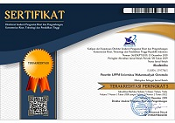FAKTOR RISIKO KEJADIAN PREEKLAMSIA DI RSIA SITI KHADIJAH GORONTALO
Abstract
Preeclampsia is one of the major causes of maternal, fetal and neonatal morbidity and mortality. The research aimed at investigating the risk factor of the preeclampsia incident in Mother and Child Hospital Siti Khadijah Gorontalo. The research used the case control study design. Case samples are mothers who suffer from preeclampsia, while control samples are mothers who did not experience preeclampsia during pregnancy. The total sample of 78 people The results of this study indicate that risk factors for the incidence of preeclampsia include socioeconomic status (OR = 3,976, CI%: 1,399 - 11,301), maternal education (OR = 4,396, 95% CI: 1,518 - 12,374), and history preeclampsia (OR = 8,441, 95% CI: 1,469 - 48,501). Maternal occupation, maternal age, history of hypertension, and parity are not risk factors for the incidence of preeclampsia. The most influential factor on the incidence of preeclampsia is the history of preeclampsia.
Preeklampsia merupakan salah satu penyebab morbiditas dan mortalitas pada ibu, janin dan neonatal. Penelitian ini bertujuan untuk mengetahui faktor yang berhubungan dengan kejadian preeklampsia di RSIA Siti Khadijah Gorontalo. Penelitian ini menggunakan desain Case Control Study. Populasi penelitian adalah semua ibu melahirkan selama tahun 2019 di RSIA Siti Khadijah Gorontalo. Sampel kasus merupakan ibu yang menderita preklamsia, sedangkan sampel kontrol merupakan ibu yang tidak mengalami preeklampsia saat hamil. Jumlah sampel sebanyak 78 orang Hasil penelitian ini menunjukkan bahwa faktor risiko terhadap kejadian preeklampsia meliputi status sosial ekonomi (OR = 3,976, CI %: 1,399 – 11,301), pendidikan ibu (OR = 4,396, CI 95% : 1,518 – 12,374), dan riwayat preeklampsia (OR = 8,441, CI 95%: 1,469 – 48,501). Pekerjaan ibu, usia ibu, riwayat hipertensi, dan paritas bukan faktor risiko terhadap kejadian preeklampsia. Faktor yang paling berpengaruh terhadap kejadian preeklampsia adalah riwayat preeklampsia.
Keywords
Full Text:
PDFReferences
Bilano, V. L., Ota, E., Ganchimeg, T., Mori, R., & Souza, J. P. (2014). Risk factors of pre- eclampsia/eclampsia and its adverse outcomes in low- and middle-income countries: A WHO secondary analysis. PLoS ONE, 9(3), 1–9.
https://doi.org/10.1371/journal. pone.0091198
Emha, M. R., Hapsari, E. D., & Lismidiati, W. (2017). Pengalaman hidup ibu dengan riwayat kehamilan preeklamsia di Yogyakarta. Berita Kedokteran Masyarakat, 33(4), 193–198.
Fatmawati, L., Sulistyono, A., & Notobroto, H. B. (2017). Pengaruh Status Kesehatan Ibu Terhadap Derajat Preeklampsia/Eklampsia di Kabupaten Gresik. Buletin Penelitian Sistem Kesehatan, 20(2), 52–58.
Guduri, G. B., Bhimarasetty, D. M., Sreegiri, S., & B, T. N. (2015). Socio-demographic determinants for hypertension in pregnancy a case-control study in a tertiary care hospital of Visakhapatnam , Andhra pradesh. (1), 93–98.
Guerrier, G., Oluyide, B., Keramarou, M., & Grais, R. F. (2013). Factors associated with severe preeclampsia and eclampsia in Jahun, Nigeria. International Journal of Women’s Health, 5(1), 509–513. https://doi.org/10.2147/IJWH.S 47056
Kemenkes. (2013). Riset Kesehatan Dasar : Pokok- pokok Hasil Riskesdan Provinsi Gorontalo Tahun 2012. Jakarta.
Kiondo, P., Wamuyu-Maina, G., Bimenya, G. S., Tumwesigye,
N. M., Wandabwa,J.,& Okong, P. (2012). Risk factors for pre-eclampsia in Mulago Hospital,Kampala,Uganda. Tropical Medicine and International Health,17(4), 480–487. https://doi.org/10.1111/j.1365- 3156.2011.02926.x
Kusika, S. Y., Masni, & Syafar, M. (2013). Faktor Risiko Kejadian Preeklampsia di Rumah Sakit Umum Anutapura Palu. (19), 0–14.
Mahande, M. J., Daltveit, A. K., Mmbaga, B. T., Masenga, G.,
Obure, J., Manongi, R., & Lie,
R. T. (2013). Recurrence of preeclampsia in Northern Tanzania: A registry-based cohort study. PLoS ONE, 8(11), 1–10.
https://doi.org/10.1371/journal. pone.0079116
Manuaba, I. A. C. (2010). Ilmu Kebidanan, Penyakit Kandungan dan KB untuk Pendidikan Bidan. Jakarta: EGC.
Mehta, B., Kumar, V., Chawla, S., Sachdeva, S., & Mahopatra,
D. (2014). Hypertension in Pregnancy: A Community- Based Study. Indian Journal of Community Medicine, 40(4), 273–278.
Mekonen, L., Shiferaw, Z., Wubshet, E., & Haile, S. (2018). Pregnancy Induced Hypertension and Associated Factors among Pregnant Women in Karamara Hospital, Jijiga, Eastern Ethiopia, 2015. J Preg Child Health, 5(379), 2.
Middendorp, D., Asbroek, A., Bio, F., Edusei, A., Meijjer, L., Newton, S., & Agyemang, C. (2013). Rural and urban differences in blood pressure and pregnancy-induced hypertension among pregnant women in Ghana. Globalization and Health, 9(1), 59.
https://doi.org/10.1186/1744-8603-9-59
Muti, M., Tshimanga, M., Notion, G. T., Bangure, D., & Chonzi,
P. (2015). Prevalence of pregnancy induced hypertension and pregnancy outcomes among women seeking maternity services in Harare, Zimbabwe. BMC Cardiovascular Disorders, 15(1),111.
https://doi.org/10.1186/s12872 -015-0110-5
Nur, A. F., & Arifuddin, A. (2017). Faktor Risiko Kejadian Preeklampsia Pada Ibu Hamil Di Rsu Anutapura Kota Palu. Healthy Tadulako, 3(2), 69– 75.
Nurhusna, & Siswanto Wilopo. (2008). Hubungan jarak kelahiran dengan kejadian preeklampsia di RSUP Dr. Sardjito Yogyakarta. Universitas Gadjah Mada.
Nursal, D. G. A., Tamela, P., & Fitrayeni, F. (2017). Faktor Risiko Kejadian Preeklampsia pada Ibu Hamil di Rsup Dr. M. Djamil Padang Tahun 2014. Jurnal Kesehatan Masyarakat Andalas, 10(1), 38–44.
Wulandari, N., & Astuti, D. (2015). Hubungan Konsumsi Makanan Sumber Antioksidan Dan Konsumsi Makanan Kaleng Dengan Kejadian Preeklampsia DI RSUD Dr. R. Goetheng Taroenadibrata Purbalingga Tahun 2015. Bidan Prada: Jurnal Publikasi Kebidanan Akbid YLPP Purwokerto, 6(2).
Article metrics
Refbacks
- There are currently no refbacks.
Copyright (c) 2019 Akademika

This work is licensed under a Creative Commons Attribution-ShareAlike 4.0 International License.
View My Stats © All rights reserved 2018, Akademika












